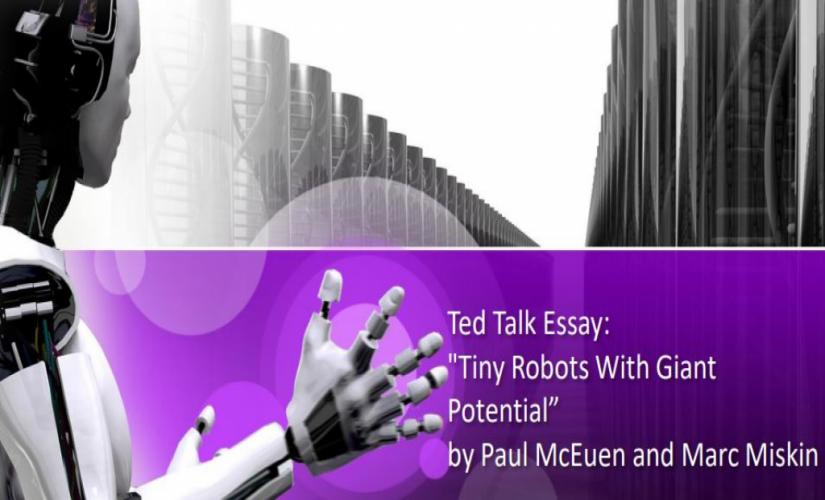An insightful watch throws light on the improved technology of microrobots. By considering this Ted Talk essay on “Tiny Robots With Giant Potential” by Paul McEuen and Marc Miskin, speakers explain machine building from existing ideas. These fascinating robots are produced in large numbers. Microrobotics are quite small and functional in any space, and the realization of their potential impact is important for the future of medical procedures, such as brachytherapy and crop management, in the control of pests and diseases.
Tiny Robots
The video’s main agenda is about the prospect of these small-sized robots in diverse fields. For example, the rotifer comparison to the robots by McEuen and Miskin made it easy to understand how these machines could function in a minute space and still be practical and useful (00:00:40-00:00:54). These microrobots get equipped to exist in any kind of environment. Hence, this perception has triggered this artistic work of engineering small robots around the world, making them impossible to see.

Humor
Speakers used humor in explaining the whole concept of designing tiny robots. For example, McEuen and Miskin state that the first clue to making one is to ‘steal’ in reference to Picasso’s famous quote (00:01:42-00:01:53). Engineers elaborate that taking ideas from technology that exists, such as from the semiconductor industries, is an essential part of making a robot. Another instance of humor is where McEuen and Miskin mention that an OWIC can get seen on Abraham Lincoln’s chest on zooming in on a penny (00:05:00-00:05:05). The illustration shows the small size of OWIC devices. Therefore, the integration of humor and concept explanation makes the whole presentation exciting and easy to comprehend.
OWIC Devices
OWIC devices are tiny, virtually unseen, and cheap. McEuen and Miskin state that these gadgets are invisible and relatively inexpensive, where each costs less than a penny (00:05:15-00:05:23). These devices are quite affordable and versatile in their use, and they can be produced in large numbers. Tiny robots have applications ranging from tagging and identification to medicine, where they have potential use in measuring neural activity. Therefore, OWIC devices show promise in a variety of industries and fields.
Positive Outcomes for Medicine
This Ted Talk may be an interesting source of learning in everything related to Leukemia. According to Nelson et al., microrobots can conduct brachytherapy to kill unwanted cells (58). If this technology is developed then, it would ease the adverse side effects that come with the treatment. Tiny robots can identify the cancer cells and destroy them without needing chemotherapy or radiotherapy. Therefore, the brilliant idea from this video should be adapted in the medical sector in the fight for diseases.
Educative Information
The information from this video is important because it is educative, especially to those in the science discipline. Medical microrobots could be valuable in less invasive surgical procedures, such as cleaning of arteries plugged up by plaque and the use of microendoscope (Cappelleri et al. par. 1; Bellouard 6). These operations could slowly replace intrusive surgical procedures. Hence, there is a great future if these machines are well utilized.
Applying Tiny Robotics
Scientists can apply this information when controlling pests and diseases in my crop production. Devices, such as e-nose technology and mesh eye surveillance system, can detect pests and diseases (Ahmed et al. 86). Tiny gadgets are useful and will also reduce the use of pesticides, which are harmful to humans, primarily when handled without protection. Hence, the application to this end will aid in pest control, which is a challenge in crop farming.
Conclusion
Thus, the Ted talk is commendable, as it introduces the concepts of microrobotics and how essential they are in performing medical tasks and identifying pests in crops. Furthermore, it elucidates the importance of having these tiny robots in the micro-world. In turn, this information can be grasped even by those who are not familiar with these fields. If the use of technologies in making a better life for humans was the objective of the video, then speakers have attained their purpose.
Works Cited
Ahmed, Hassan., et al. “Introduction to Robotics Agriculture in Pest Control: A Review.” Pertanika Journal of Scholarly Research Reviews, vol. 2, no. 2, 2018, pp. 80-93.
Bellouard, Yves. Microrobotics: Methods and Application. CRC Press, 2010.
Cappelleri, David J., et al. “Tumbling Microrobots for Future Medicine.” American Scientist, 2020, www.americanscientist.org/article/tumbling-microrobots-for-future-medicine.
McEuen, Paul, and Marc Miskin. “Tiny Robots With Giant Potential.” TED, 2019, www.ted.com/talks/paul_mceuen_and_marc_miskin_tiny_robots_with_giant_potential.
Nelson, Bradley J., et al. “Microrobots for Minimal Invasive Medicine.” The Annual Review of Biomedical Engineering, vol. 12, 2010, pp. 58-85.


